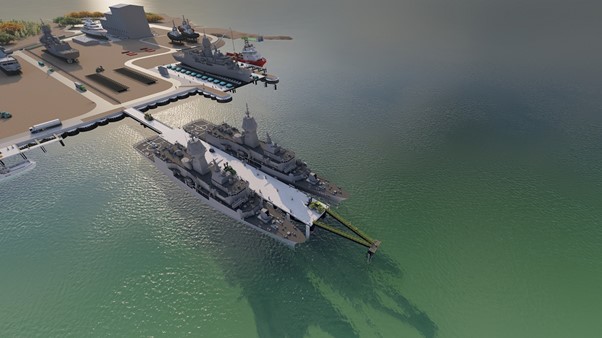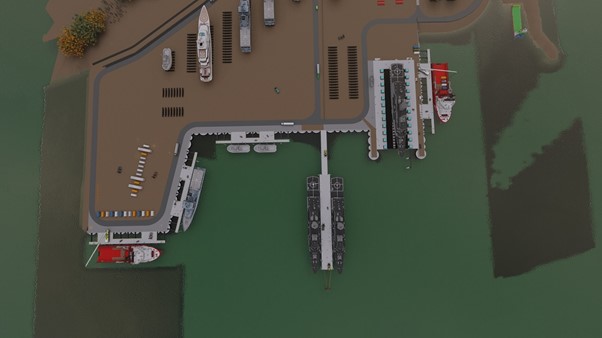Northern Territory building infrastructure for the future
Posted By Louise McCormick on August 10, 2022 @ 06:00

There’s a lot of myth and mystery surrounding northern Australia. Residents of the Northern Territory revel in the southern states’ characterisation of it as a frontier land. We’re less amused when we’re portrayed as Australia’s economic Oliver Twist begging, ‘Please, sir, I want some more.’ The truth is, northern Australia is thinking big to sustain its own economic future. And there’s no better example than the development of Darwin’s ship lift, which will provide a site for maintenance and servicing of Department of Defence and Australian Border Force vessels as well as commercial and private vessels.
Historically, Defence and associated sustainment industries have been a key economic sector for northern Australia. Territorians have long understood our important relationship with Defence and the role we would play in defending Australia from the north if that became necessary. From the 1930s until World War II, Darwin was recognised as the nation’s most strategic northern port. Significant infrastructure upgrades were made to support expansion in the north, including the sealing of the Stuart Highway, which remains our main arterial connection to the south to this day.
And Darwin is still Australia’s most strategic port in the north.
Its harbour is one of the largest in Australia, with natural deep water ideal for large vessels and 3,227 square kilometres of land and water. Centrally positioned on Australia’s northern coastline, Darwin is the only significant vessel-servicing point between Cairns and Perth. Its strategic location in the Indo-Pacific also reduces vessel travel costs by providing an alternative to maintenance facilities interstate and overseas.
Darwin Harbour is a key enabler for the national and Northern Territory economies. Darwin is recognised as a globally significant export hub for liquefied natural gas. Exports of LNG generate more than a fifth of the territory’s gross state product. The NT supplies more than 10% of Japan’s and Taiwan’s annual gas imports. The global disruption to gas supplies from the war in Ukraine means the LNG industry is set to grow.
Last month, the NT government announced the preferred contractor for the Darwin ship lift project, a joint venture between Clough and BMD. With a total budget of $515 million, the project will deliver a common-user facility with a lifting capability of 5,500 tonnes, six wet berths, a hardstand area for ship repair and maintenance works plus associated transfer assets, and a dedicated washdown bay and blast and paint facility.

The Northern Australian Infrastructure Facility has loaned the NT government $300 million to deliver this key project.
The ship lift will support Defence operations as well as pearling, commercial fishing and other maritime industries in Australia’s northern waters and the international waters beyond.
The importance of the ship lift, and the development of the harbour more broadly, is reinforced by increasingly uncertain global conditions coupled with an expanding Defence presence and strong growth agenda in Australia’s north. The lift will expand on existing assets to create northern Australia’s largest and most efficient marine servicing hub, catering for all vessels with maintenance, servicing, engineering, fabrication and logistics activities.
The ship lift is the first piece of enabling infrastructure in a broader growth agenda. By 2030, the territory government aims to have a sustainable and diverse $40-billion economy, a population of 300,000 and 35,000 more jobs. A new infrastructure framework [1] aligns planning and investment. The NT infrastructure strategy 2022 to 2030 [2] describes how infrastructure investment will enable growth of the economy and population underpinned by sustainability and resilience.
The development of a marine industry park at East Arm and a sustainable development precinct at Middle Arm will significantly increase Darwin’s capacity, capability and economic output.
The industry park being developed by the NT government-owned Land Development Corporation will be strategically located on the waterfront. It will use existing infrastructure, including a hardstand and all-tide barge ramp; established air, sea, road and rail transport links; and its proximity to East Arm Wharf, the Top End Marine Supply Base and Darwin Business Park. The park will be a precinct of marine-related industries with large areas of harbour-front land alongside the ship lift.
Across the harbour from the ship lift and industry park will be the Middle Arm Sustainable Development Precinct. Already home to internationally significant gas facilities for Inpex (Ichthys Onshore LNG) and Santos (Darwin LNG), the 1,500-hectare site will be available for low-emissions manufacturing and related processes including energy development; carbon capture, use and storage; petrochemicals; minerals processing; hydrogen; and advanced manufacturing. The precinct offers significant opportunities to support national energy security and supply-chain resilience and can lead the way to energy transition globally by unlocking the comparative advantages the NT has in abundance—strong sunlight, regular rainfall in the wet season and 14 of the 17 critical minerals needed for a sustainable future.
The NT government is working with industry and the Australian government to accelerate the development of Middle Arm. In March 2022, the Australian government committed $2 billion for the sustainable development precinct there including $1.5 billion for marine infrastructure with a common-user modular offloading facility and widening the shipping channel to give larger vessels access.
At the time of the funding announcement, there was conjecture that the investment was for a second port. The choice to invest in dredging and a modular offloading facility doesn’t support general port cargo but enhances the port’s ability to accept large or heavy cargo for manufacturing. This marine infrastructure is needed to support export of low-emissions products from the precinct. National and territory goals include sustainable jobs, increased manufacturing in Australia and helping transition the energy sources of the nation and the world towards a net-zero-emissions future.
There’s a lot of ill-informed commentary on the capacity of northern Australia to support defence and broader nation-building and assumptions that the NT government and other northern jurisdictions are waiting for defence investment. We’re not. We are proactively building our nation and are ready to partner closely with a range of stakeholders and investors.
Investment in enabling infrastructure will unlock the potential of Darwin Harbour and build on the NT’s natural competitive advantages, including its renewable energy sources, critical mineral reserves and proximity to international markets. Delivery of the ship lift, industry park and sustainable development precinct will establish Darwin as a world leader in emerging global industries.
Article printed from The Strategist: https://www.aspistrategist.org.au
URL to article: https://www.aspistrategist.org.au/northern-territory-building-infrastructure-for-the-future/
URLs in this post:
[1] infrastructure framework: https://dipl.nt.gov.au/strategies/nt-infrastructure-framework
[2] NT infrastructure strategy 2022 to 2030: https://dipl.nt.gov.au/__data/assets/pdf_file/0006/1115583/nt-infrastructure-strategy2022.PDF
Click here to print.